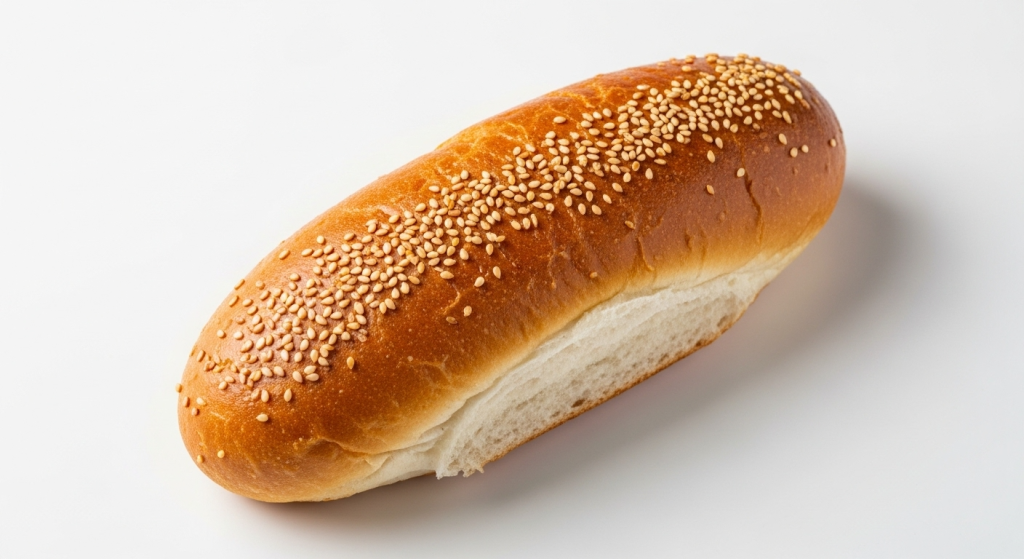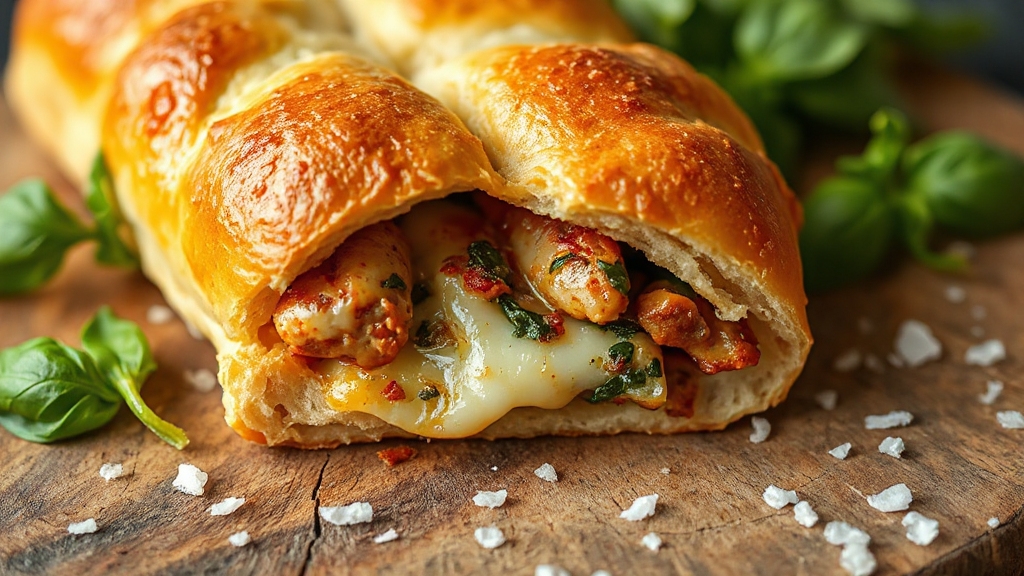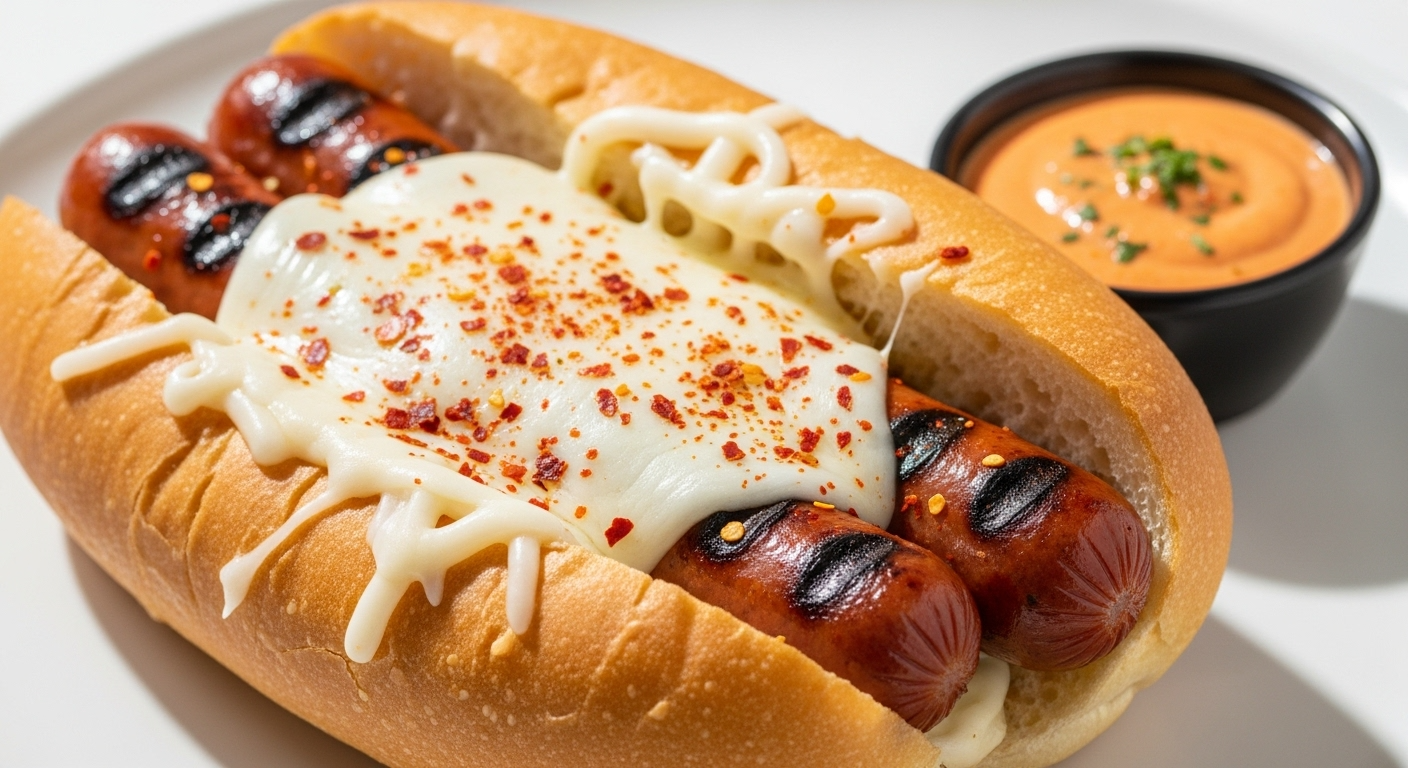Italian Hot Dog Bread: Delight in Timeless Flavor
Newark’s best-kept secret isn’t found in fancy restaurants—it’s wrapped in a humble piece of bread that changed American sandwiches forever. Italian hot dog bread represents a culinary masterpiece that emerged from New Jersey’s Italian immigrant community, combining pizza-making techniques with sandwich innovation.
This sturdy yet tender bread solves every hot dog lover’s nightmare: soggy, falling-apart buns. Crafted with olive oil and high-gluten flour, it creates the perfect vessel for loaded Italian hot dogs. You’ll uncover the 1932 origin story behind this Newark legend and master the authentic recipe techniques that produce bread strong enough to hold two hot dogs plus a mountain of vegetables.
Ready to discover why this pizza-style bread has remained unchanged for nearly a century? The secrets lie in understanding its unique dough composition and traditional shaping methods.
Key Takeaways
- Italian hot dog bread is a soft, chewy, sturdy pizza bread made with olive oil, high-gluten flour, and yeast for durability and flavor.
- It is shaped like a large, round, pocket-style roll that holds two hot dogs and generous vegetable fillings securely.
- The bread has a mild, slightly savory taste enriched with olive oil and milk, differing from sweeter traditional hot dog buns.
- This bread originated in Newark, New Jersey, as part of Italian-American culinary tradition, reflecting local immigrant heritage.
- Its durable, pillowy crumb balances softness and structure, perfect for supporting hot dogs topped with fried potatoes, onions, and peppers.
Complete Italian Hot Dog Bread Recipe
| Ingredients | Process |
|---|---|
| For the Bread: | |
| 3½ to 4 cups bread flour (455g to 520g) | Combine warm water, sugar, and yeast in a large bowl. Let proof for 5-10 minutes until foamy |
| 1½ cups warm water (about 110°F) | Add flour, olive oil, and salt to the yeast mixture |
| 2 teaspoons granulated sugar | Stir with wooden spoon or mix with dough hook until combined |
| 2¼ teaspoons active dry yeast | Knead for 5 minutes with stand mixer or 6-7 minutes by hand until smooth and elastic |
| 2 tablespoons olive oil | Place dough in oiled bowl, cover, and let rise 30 minutes to 1½ hours until doubled |
| 2 teaspoons salt | Preheat oven to 475°F while dough rises |
| For Assembly: | Divide dough in half and roll into 8-inch circles, about ¾ to 1-inch thick |
| 4-6 beef hot dogs | Create 1-inch hole in center with finger or wooden spoon handle |
| 1 pound Yukon gold potatoes, sliced ¼” thick | Transfer to parchment-lined baking sheet |
| 1 yellow onion, sliced | Bake 15-20 minutes until golden brown |
| 1 bell pepper, sliced | Cool completely before cutting into quarters |
| 4-6 tablespoons olive oil | Heat olive oil in large skillet over medium-high heat |
| 1 teaspoon dried oregano | Fry hot dogs until crispy and set aside |
| ½ teaspoon crushed red pepper flakes | Sauté potatoes until golden and tender |
| Salt and pepper to taste | Add onions and peppers, cook until softened |
| Yellow or brown mustard | Season vegetables with oregano, red pepper flakes, salt, and pepper |
| Slice bread quarters to create pockets | |
| Fill with hot dogs and vegetable mixture | |
| Add mustard as desired and serve immediately |
Origins of the Italian Hot Dog

Although many regional hot dog variations exist, the Italian hot dog stands out for its unique origin in Newark, New Jersey, where James “Buff” Racioppi and his wife Mary first crafted this iconic sandwich in 1932. The soft, round “pizza bread” used in the original sandwich requires a careful slicing technique to maintain its texture, often achieved using a serrated bread knife.
You’ll find that the original Italian hot dog features two hot dogs nestled in soft, round “pizza bread,” not the typical bun you’d expect.
Mary was the first to prepare it, serving friends during card games hosted by James, nicknamed “Buff” for his playing style.
The sandwich’s distinct toppings—fried potatoes, peppers, and onions—add a flavorful crunch that sets it apart.
Its popularity quickly grew, leading the Racioppi family to open Jimmy Buff’s restaurant, cementing the Italian hot dog as a beloved New Jersey staple.
Today, the Italian hot dog remains primarily a New Jersey specialty, with several dedicated establishments continuing to serve the dish.
The Role of Newark’s Italian Community
When you explore Newark’s rich cultural tapestry, the Italian community stands out as a vibrant and foundational thread. Settling in the First Ward from the 1870s, these immigrants shaped a lively neighborhood known as Little Italy. Their churches, festivals, and culinary traditions created a tight-knit community, preserving Italian heritage through food and faith.
Early Italian arrivals included families with members fluent in English, which helped ease their integration challenges. This strong community spirit also fostered sensory exploration through shared culinary and cultural experiences.
| Heritage Roots | Cultural Festivals | Culinary Fame |
|---|---|---|
| First Ward enclave | Feast of St. Gerard | Giordano’s Bakery |
| Angelo Maria Mattia | St. Lucy’s Church | Hot dog bread fame |
| 30,000+ residents | Religious processions | Celebrity patrons |
You can feel Newark’s Italian spirit in every bite of their iconic hot dog bread, a delicious legacy of this historic community.
Key Ingredients in Italian Hot Dog Bread

You’ll want to start with the right bread—soft, chewy, and sturdy enough to hold all the delicious fillings without falling apart. Traditional Italian hot dog bread pairs perfectly with classic meats like Italian sausage or hot dogs, delivering rich, savory flavors. This bread is often made from a special pizza bread dough that includes olive oil, yeast, and bread flour, giving it a unique texture and taste.
Don’t forget the fresh vegetable toppings, which add crunch and brightness, balancing each bite with a variety of textures. Using the right dough composition ensures the bread maintains its structure and complements the filling perfectly.
Essential Bread Characteristics
Since the foundation of Italian hot dog bread lies in its ingredients, understanding the essential components is key to mastering its unique texture and flavor. You’ll want to focus on flour type, hydration, and fat content to achieve that classic chewy yet tender crumb. Here’s a quick glance at what shapes this bread:
| Component | Role | Effect on Bread |
|---|---|---|
| Bread Flour | High gluten content | Chewy, resilient crumb |
| Extra Virgin Olive Oil | Enhances extensibility | Soft crumb, thin crisp crust |
| High Hydration | Wet dough | Open crumb, sturdy structure |
Balancing these elements guarantees a bread that’s soft enough to bite into but strong enough to hold your fillings perfectly. It’s important to note that the bread used in a traditional New Jersey Italian hot dog is typically a muffuletta-style sandwich roll, which is larger and sturdier than standard hot dog buns.
Using the right flour and hydration levels, as well as precise temperature control during fermentation, can greatly improve the final texture and flavor of your dough, similar to techniques employed in artisan bread programs.
Traditional Meat Choices
Although the Italian hot dog bread provides a sturdy, chewy base, the choice of meat truly defines the sandwich’s character.
You’ll find that classic versions rely on all-beef hot dogs, prized for their robust flavor and firm texture. These hot dogs are often deep-fried to create a crispy casing that contrasts beautifully with the juicy interior. Using high-quality cooking oils enhances the flavor while maintaining health standards.
Some regional twists swap in Italian sausages, grilled or fried, adding spiced, savory notes.
Here’s what you should know about traditional meat choices:
- All-beef hot dogs are preferred for their bold taste and ability to hold up against hearty bread and toppings.
- Deep-frying enhances texture, delivering a crunchy outside and moist inside.
- Italian sausages offer a flavorful alternative, bringing a spicy complexity to the sandwich.
- The hot dogs in authentic Italian Hot Dogs are typically cooked in cholesterol-free soybean oil, ensuring a healthier preparation.
Vegetable Fillings Variety
When you bite into an Italian hot dog bread, the vibrant medley of sautéed vegetables plays an essential role in balancing the savory meats and hearty bread.
Yukon gold potatoes, sliced thin and pan-fried in olive oil, add tender texture and mild flavor. Yellow onions, sautéed until translucent or lightly caramelized, bring a subtle sweetness and depth. Vibrant green, red, and yellow bell peppers contribute a sweet, tangy contrast and eye-catching color. Using premium food-grade ingredients ensures the freshest flavors and best texture in the filling.
Seasoned simply with salt, pepper, oregano, and crushed red pepper flakes, these vegetables meld into a fragrant, cohesive filling. Sometimes, creamy garlic sauce or basil pesto enhances moistness and flavor complexity. The vegetables are sautéed with traditional seasonings that reflect the regional culinary culture of New Jersey, where Italian hot dogs originated.
This colorful, well-seasoned vegetable mix perfectly complements the rich meats, making each bite of Italian hot dog bread a satisfying experience.
The Unique Pizza Bread Explained

You’ll notice the pizza bread’s soft yet sturdy texture perfectly holds all the hearty fillings without falling apart. Its mild flavor acts as the ideal backdrop, letting the bold mustard, peppers, and fried potatoes shine. This bread isn’t just a vessel—it shapes the entire Italian hot dog experience.
The bread’s durability is similar to that of durable stoneware, which helps maintain freshness and texture. Uniquely found in Newark bakeries, this round, soft pizza bread is pulled apart to create a pocket that defines the sandwich’s signature style.
Texture and Flavor
Because the bread is the foundation of the Italian hot dog, its texture and flavor play a crucial role in the overall experience. You’ll notice the dough is extra-fluffy and airy, offering a pillowy yet chewy bite that perfectly supports the hearty fillings. Its mild, neutral flavor, enriched subtly with milk and olive oil, acts as a blank canvas, enhancing rather than overpowering the savory ingredients.
The bread’s unique structure opens like a pita pocket, making it easy to stuff while keeping everything intact. This pizza dough is shaped into a pita-like vessel, which distinguishes the Italian hot dog from traditional hot dogs. Using natural ingredients and proper storage techniques like linen bread bags can help maintain the bread’s freshness longer.
- Pillowy crumb with enough structure to hold fillings without crumbling
- Mild, slightly savory flavor with a subtle richness from olive oil
- Soft crust balances pliability and durability for a satisfying bite
Bread’s Role
Although it might resemble a typical bun at first glance, the pizza bread used in Italian hot dogs stands apart with its unique composition and purpose. This soft, round bread from Newark, NJ, supports hearty fillings like fried hot dogs, potatoes, peppers, and onions without falling apart. Its half-loaf shape and absorbent texture balance structure and flavor, soaking up oils and mustard while keeping everything intact.
The pizza bread is sourced from renowned local bakeries like Sorrento Bakery and Nicolos Italian Bakery, which contributes to its authentic taste and texture. Pizza bread isn’t just a vessel—it’s a flavor carrier and cultural symbol rooted in Italian-American tradition, crafted to enhance your Italian hot dog experience.
The bread’s design parallels the importance of proper size and depth in Sicilian pizza pans, ensuring it can hold substantial fillings without compromising integrity.
| Role | Description |
|---|---|
| Structural | Holds multiple juicy, oily fillings securely |
| Flavor Carrier | Absorbs oils and mustard, complements fillings |
| Cultural Symbol | Reflects Italian immigrant baking heritage |
| Textural Balance | Soft yet sturdy, contrasts crispy fillings |
Traditional Preparation Techniques
When preparing Italian hot dog bread traditionally, you start by carefully crafting a yeast-based dough that balances moisture and structure through ingredients like warm water, olive oil, and all-purpose flour. This dough often resembles a pizza dough or enriched bread dough, which contributes to its light, fluffy texture. You knead the dough until smooth and elastic, then let it rise until doubled.
After dividing it into equal portions, you shape each into a ball, creating a hollow center for the hot dog. Keep these techniques in mind:
- Coat dough lightly with olive oil before rising to prevent drying.
- Use a wooden spoon handle to create the perfect hollow in each roll.
- Bake at 475°F on a preheated tray for a golden crust and soft interior.
Cultural Significance and Festive Appeal
If you’ve ever wandered through an Italian-American festival in New Jersey, you’ve likely encountered the vibrant aroma and hearty appeal of the Italian hot dog. This dish isn’t just food—it’s a lively celebration of Italian immigrant heritage, blending southern Italian flavors like peppers and onions with American street food.
Hot dogs, including variants like the Italian hot dog, are often served in buns with a variety of condiments and toppings that enhance their flavor and cultural significance. At festivals honoring Italian saints or neighborhood fairs, you’ll see the Italian hot dog bringing people together, sparking nostalgia and pride.
Its colorful toppings and generous portions create a festive atmosphere that echoes through generations. Bakers often use specialized proofing baskets to prepare the perfectly risen buns that hold these delicious hot dogs.
Whether in Newark’s pizza bread or Trenton’s torpedo roll, these variations symbolize local identity and community spirit. When you bite into one, you’re tasting a rich cultural legacy, celebrated in joyful, communal gatherings that keep tradition alive.
Differences From Classic Hot Dog Buns
The Italian hot dog’s vibrant flavors and festive appeal start with a bread that stands apart from the classic hot dog bun you’re used to. Unlike the soft, sweet, and often fragile traditional bun, Italian hot dog bread boasts a pillowy yet chewy texture, enriched with olive oil for durability and flavor. It’s designed to hold hearty fillings without falling apart, making every bite satisfying.
Italian hot dog bread offers a chewy, olive oil-enriched texture that holds hearty fillings without falling apart.
Here’s what sets it apart:
- Shape & Size: Larger, rounder, sometimes pocket-like, perfect for stuffing fries and multiple sausages.
- Texture: Airy yet sturdy crumb that handles heavy fillings better than fluffy classic buns. This sturdiness is essential as it provides the structural integrity needed to support toppings-heavy and luxurious fillings like lobster or brats.
- Flavor: Mild olive oil richness with subtle yeastiness, contrasting the sweet, neutral taste of typical buns.
This bread is truly built for bold, generous Italian hot dogs.
Legacy of Jimmy “Buff” Racioppi
Though many foods become lost to time, Jimmy “Buff” Racioppi’s creation of the Italian hot dog in 1932 continues to shape Newark’s culinary landscape.
You’ll find that this iconic dish, born from a clever blend of fried hot dogs, green peppers, onions, and potatoes on pizza bread, has become synonymous with Jimmy Buff’s legacy.
The Racioppi family has preserved this recipe for over 90 years, serving it at family-run spots in New Jersey, keeping the tradition alive and authentic.
One notable location where you can enjoy this classic dish is Jimmy Buff’s Italian Hot Dogs in West Orange, New Jersey.
When you bite into an Italian hot dog, you’re tasting a unique fusion of Italian-American culture that’s deeply rooted in Newark’s identity.
Jimmy Buff’s influence lives on, not just in flavor, but as a symbol of immigrant innovation in local cuisine.
Frequently Asked Questions
Where Can I Buy Authentic Italian Hot Dog Bread Outside New Jersey?
If you’re craving that distinctive Italian hot dog bread outside New Jersey, your best bet is ordering from NJ suppliers like Jimmy Buff’s via Goldbelly—they ship nationwide.
You can also check specialty bakeries in cities with strong Italian-American communities, like New York or Philadelphia; they sometimes offer close alternatives.
For a dining experience, places like St. Anselm in Brooklyn serve authentic versions, using bread imported or baked to replicate the NJ style.
Can Italian Hot Dog Bread Be Made Gluten-Free?
You can definitely make Italian hot dog bread gluten-free, but it takes some tweaks. Swap traditional bread flour for a gluten-free blend, add xanthan gum for elasticity, and increase water slightly to keep the dough moist.
Expect a denser texture since gluten’s missing, but using psyllium husk or flaxseed meal helps improve chewiness. With some patience and experimentation, you’ll enjoy a tasty, gluten-free version that pairs perfectly with classic fillings.
What Is the Best Way to Store Leftover Italian Hot Dog Bread?
To keep your leftover bread fresh, store it in an airtight container or bag to avoid drying out.
If you plan to eat it soon, keep it at room temperature to prevent moisture buildup.
For longer storage, freeze it tightly wrapped.
When ready, thaw it at room temperature and reheat wrapped in foil at 300°F for 10 minutes to restore softness.
Avoid refrigerating bread, as it can make it stale faster.
Are There Vegetarian Versions of Italian Hot Dog Bread?
You’re in for a delightful surprise—there are gentle alternatives that honor your plant-based journey. You can enjoy dough made with wheat flour, non-dairy milk, and oils instead of animal products, creating soft, pillowy buns.
Vegan sausages and condiments crafted without eggs or dairy add layers of flavor without compromise. These thoughtful versions keep tradition alive while embracing compassion, so you can savor every bite with a clear conscience and full heart.
How Long Does Italian Hot Dog Bread Stay Fresh After Baking?
You’ll find freshly baked bread stays at its best for about 5 to 7 days when stored properly. Keep it in a cool, dry place, sealed tightly to lock in moisture and avoid staleness.
Avoid refrigerating unless it’s really hot, as that speeds up drying.
If you notice any mold, sour smells, or hardness, it’s time to toss it.
Enjoy your bread fresh within that week for the best taste and texture!
Timeless Flavor, Unforgettable Legacy
You’ll find that Italian hot dog bread is more than just a bun—it’s a warm embrace from Newark’s rich Italian heritage.
Like a comforting melody that lingers in your heart, its soft, pizza-like texture and unique flavors bring history and culture to every bite. Whether you’re savoring it at a bustling street vendor or making it at home, this bread connects you to a vibrant legacy that’s as timeless as it is delicious.







